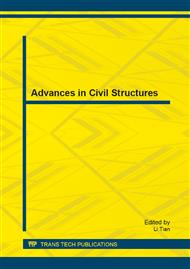p.1088
p.1092
p.1097
p.1102
p.1108
p.1112
p.1117
p.1122
p.1130
Analysis of Effective Pre-Stress and Stiffness of the Continuous Rigid Frame Bridge in Service Based on Inversion Theory
Abstract:
Due to the shrinkage, creep, friction and other factors, the pre-stress applied to the beam is not a constant. It is important to obtain the information of the pre-stress in order to ensure security of the bridge in service. To solve the problem mentioned above, the paper puts forward a new way to analyze the effective pre-stress using the displacement inversion method based on the inversion theory according to the measured vertical deflection of the bridge in service at different time. The method is a feasible way to predict the effective pre-stress of the bridge in service. Lastly, taking the pre-stressed concrete continuous rigid frame bridge for example, the effective pre-stress and stiffness are analyzed by establishing the finite element model.
Info:
Periodical:
Pages:
1108-1111
Citation:
Online since:
August 2013
Authors:
Price:
Сopyright:
© 2013 Trans Tech Publications Ltd. All Rights Reserved
Share:
Citation:


